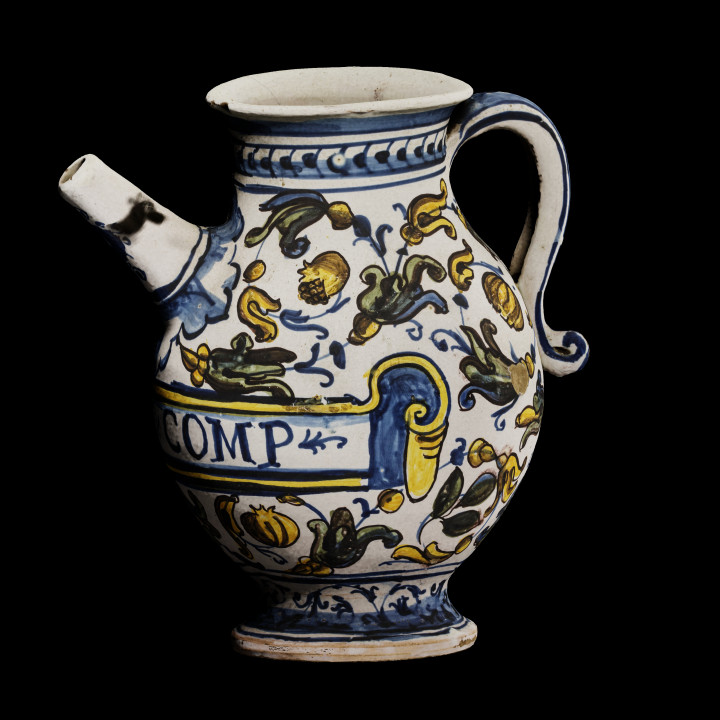
Apothecary vessel for bishop's wort syrup
myminifactory
The presented majolica apothecary vessel comes from the collection of Mateusz Bronisław Grabowski (1904–1976). The belly of the vessel is egg-shaped and transitions into a neck ending with a rolled collar surrounding a tubular spout. The jug's handle is in the shape of a batten curled at the base. The vessel is decorated with colorful plant ornament. Below the tubular spout, there is an apothecary signature. It is in a form of a band with rolled ends. On the band, there is an inscription: SY [RUPUS] BETT [ONICAE] COMP [OSITUS], meaning a fixed-combination syrup made from bishop's wort. The main component of this preparation was bishop's wort ( Betonica officinalis L.) - a raw material with mild astringent activity as well as anti-inflammatory and anti-hemorrhagic properties. Other ingredients included: marjoram (Origanum majorana L.), thyme ( Thymus vulgaris L.), dog rose ( Rosa canina L.), French lavender ( Lavandula stroechas L.), sage ( Salvia officinalis L.), wood violet ( Viola odorata L.), fennel seeds ( Foeniculum officinale L.), anise seeds ( Pimpinella anisum L.), caraway seeds ( Carum carvi L.), peony root ( Peonia L.), common polypody ( Polypodium vulgare L.) and fennel root ( Foeniculum officinale L. ) Grabowski's collection consists of 83 ceramic apothecary vessels made in the period from the 16th to the 19th century in Italian, Dutch, British and French manufactories. They are some of the most valuable exhibits of the Museum of Pharmacy at the Jagiellonian University Medical College. The creator and donor of the collection was the Master of Pharmacy Mateusz Bronisław Grabowski (1904–1976), a pre-war pharmaceutical inspector of the Warsaw Voivodeship, soldier in the September campaign of 1939, member of the Polish Armed Forces in the West, and later, an emigrant entrepreneur and patron of the arts. In years 1948-1976, he ran a pharmacy in central London as well as the thriving Grabowski Export-Import company, which exported medicines to Poland and other countries behind the Iron Curtain..In 1959, he founded a contemporary art gallery, ie the Grabowski Gallery, which was located right next to his company. It was not profit-oriented, but its owner decided to bestow his patronage on both Polish and young, aspiring artists of other nationalities. The first European pop art show was held there in 1962. At Grabowski's Gallery, Jan Czapski, Wojciech Fangor, Magdalena Abakanowicz, Derek Boshier, Pauline Boty and many other creators presented their works. During nearly sixteen years of promotional and exhibition activities, Mateusz Grabowski amassed a private collection of 386 works of art. In 1975, he donated it to the Museum of Art in Łódź and the National Museum in Warsaw. The pharmacist also collected apothecary pottery, which he donated to the Museum of Pharmacy in Kraków. In 1975, in London, he created a foundation in his name - the MB Grabowski Fund, devoting a significant portion of his wealth to this purpose. Its task is to promote Polish culture and science in Great Britain. Majolica includes ware made of baked clay and covered in tin-lead glaze. They are produced using a technique originating from the Middle East. Over time, the technique also spread in the Iberian Peninsula and subsequently, in Italy. The majolica originating in those regions was particularly popular during the Renaissance and became one of the art symbols of the period. The most important ceramic centers included: Faenza, Urbino, Deruta, Venice, Rome, Montelupo and Savona. Majolica products were very expensive, which is why ordering a set of apothecary dishes emphasized the high economic status of the pharmacy owner. Grabowski's collection includes: vessels (for liquid medicines), vases, jars (including albarella) and tins (for semi-liquid and solid medicines). The names of the preparations, most often in Latin, were typically placed in cartouches painted on the walls of the vessels. There are also unlabelled containers, which may have belonged in a home medicine kit of a wealthy owner. Later on, empty spaces were left on the vessels, in which the names of the medicines could be written according to current ne
With this file you will be able to print Apothecary vessel for bishop's wort syrup with your 3D printer. Click on the button and save the file on your computer to work, edit or customize your design. You can also find more 3D designs for printers on Apothecary vessel for bishop's wort syrup.
